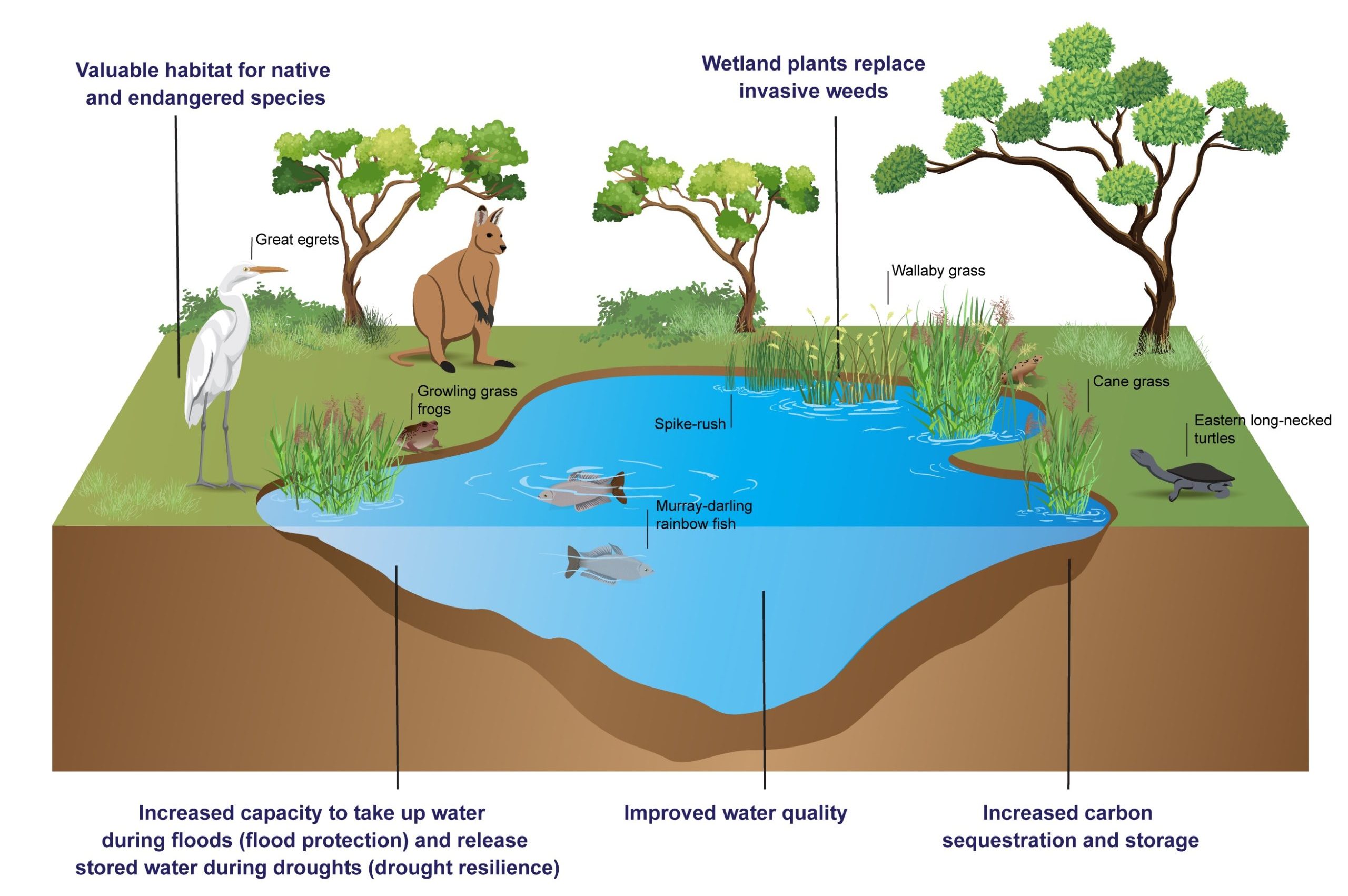REVITALISING AUSTRALIA'S FRESHWATER WETLANDS
Freshwater wetlands perform many functions and are vital for environmental, economic, social, and cultural reasons.
Freshwater wetlands provide important ecosystem services, including carbon sequestration and long-term storage, refuge for native biodiversity, flood protection, and hydrological services such as water purification, retention, and supply during droughts.
Natural wetlands in Australia sequester up to 6.93 Mg C ha-1 year-1. However, the drainage and conversion of freshwater wetlands for crop or livestock agriculture can deteriorate such services. Degraded wetlands can release significant amounts of previously stored carbon back into the atmosphere in the form of greenhouse gases (e.g., CO2, CH4), thus contributing to climate change, reduce water storage and availability, which can result in reduced flood protection and drought resilience, and drive species decline and extinction.
Similarly, the use of fertilisers can promote the production of nitrous oxide (N2O), a potent greenhouse gas with a global warming potential 273 times that of CO2 on a 100 year timescale.
Our work
We aim to restore and revitalise freshwater wetlands by reinstating their natural hydrology and returning the land to its natural condition.
- We engage with farmers and landowners to identify degraded wetlands
- We use rewetting techniques to bring them back to their original condition.
- We work with indigenous rangers to combine traditional knowledge with conservation training to protect restored sites.
- We engage with stakeholders to discuss incentives for restoration practices, such as generating Australian Carbon Credit Units (ACCUs) by restoring wetlands.
Our partners include the Wetland Revival Trust, the Arthur Rylah Institute for Environmental Research, the Dja Dja Wurrung Aboriginal Corporation, and several management authorities (see below).
The Blue Carbon Lab is at the forefront of international efforts to understand the value of natural wetlands. We published the first large-scale estimates of carbon sequestration from natural wetlands in the southeast of Australia (Carnell et al. 2018). We also showed that excluding grazing from wetlands by installing fences can increase soil carbon concentration by up to 30%, while reducing greenhouse gas emissions by 30% (Limpert et al. 2021). Similarly, excluding livestock from natural wetlands using fences can boost plant biomass and primary production (Treby et al. 2020), whereas active restoration efforts such as environmental watering can reduce greenhouse gas emissions by 28-84% (Limpert et al. 2020).

The benefits of restoring degraded freshwater wetlands
The benefits of restoring natural wetlands include:
- Increased carbon storage, with an estimated 28-84% reduction in GHG emissions (Limpert et al. 2020)
- Provision of habitat for native and endangered species
- Increased water security for agriculture and drought resilience due to increased water holding capacity
- Protection from flooding
- Recreational space for farmers and community
- Cultural significance for Indigenous people
Selected Publications
- Schuster, L., Taillardat, P., Macreadie, P. I., & Malerba, M. E. (2024). Freshwater wetland restoration and conservation are long-term natural climate solutions. Science of The Total Environment, 171218.
- Bonetti, G., Limpert, K. E., Brodersen, K. E., Trevathan-Tackett, S. M., Carnell, P. E., & Macreadie, P. I. (2022). The combined effect of short-term hydrological and N-fertilization manipulation of wetlands on CO2, CH4, and N2O emissions. Environmental Pollution. https://doi.org/10.1016/j.envpol.2021.118637
- Limpert, K. E., Carnell, P. E., & Macreadie, P. I. (2021). Managing agricultural grazing to enhance the carbon sequestration capacity of freshwater wetlands. Wetlands Ecology and Management. https://doi.org/10.1007/s11273-020-09780-7
- Limpert, K. E., Carnell, P. E., Trevathan-Tackett, S. M., & Macreadie, P. I. (2020). Reducing emissions from degraded floodplain wetlands. Frontiers in Environmental Science. https://doi.org/10.3389/fenvs.2020.00008
- Treby, S., Carnell, P. E., Trevathan-Tackett, S. M., Bonetti, G., & Macreadie, P. I. (2020). Assessing passive rehabilitation for carbon gains in rain-filled agricultural wetlands. Journal of environmental management. https://doi.org/10.1016/j.jenvman.2019.109971
- Carnell, P. E., Windecker, S. M., Brenker, M., Baldock, J., Masque, P., Brunt, K., & Macreadie, P. I. (2018). Carbon stocks, sequestration, and emissions of wetlands in south eastern Australia. Global Change Biology. https://doi.org/10.1111/gcb.14319
Funding & Program Partners
This program is managed by Dr Lukas Schuster, Dr Martino Malerba, Dr Paul Carnell, and Dr Stacey Trevathan-Tackett from the Blue Carbon Lab.
The Australian Research Council funded this project through a DECRA fellowship awarded to Dr Malerba. Other partners include the Wetland Revival Trust; Arthur Rylah Institute for Environmental Research; Department of Environment, Land, Water and Planning (DELWP); Murray Darling Wetlands Working Group (MDWWG); North Central Catchment Management Authority (NCCMA).



